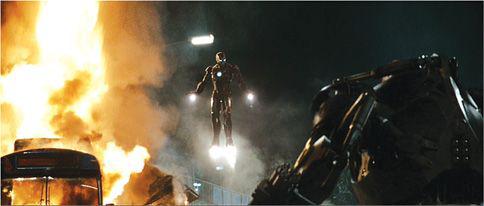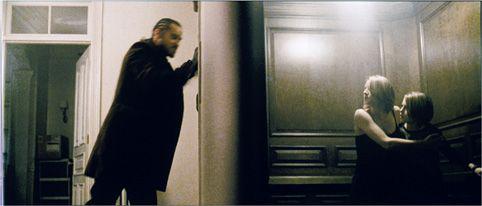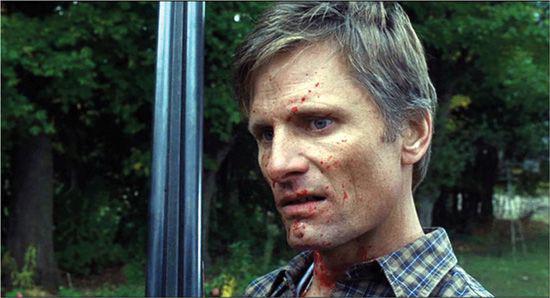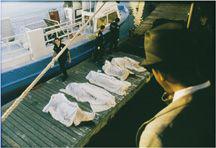B0041VYHGW EBOK (135 page)
Authors: David Bordwell,Kristin Thompson

How are genre categories used? They certainly affect industry officials’ decisions about what films to make. While big-budget musicals such as
The Sound of Music
were commonly produced in the 1960s, they are out of fashion now, and more recent musicals such as
Chicago
and
Mamma Mia
were not expensive to produce. On the other hand, horror and action films are currently popular, and executives would be likelier to green-light projects perceived to fit into those genres.
For the vast publicity system that exists around filmmaking, genres are a simple way to characterize a film. In fact, reviewers are often central in gathering and crystallizing notions about genres. In television coverage of entertainment, reporters refer to genres, because they know that most members of the public will easily grasp what they mean.
You may also find that some reviewers tend to dismiss genre films as shallow and trivial, assuming them to be simply formulaic: it’s only a Western; it’s just a horror film. Undoubtedly, many films in all genres are cheaply and unimaginatively made. Yet some of the greatest films also fall into genres.
Singin’ in the Rain
is arguably also one of the best American films.
Grand Illusion
is a war film.
Psycho
is a thriller.
The Godfather
is a gangster film. On the whole, genre is a category best used to describe and analyze films, not to evaluate them.
For viewers, genre often provides a way of finding a film they want to see. If a group plans an evening at the movies, members may express their preferences for a science fiction film, or a thriller, or a romance and then negotiate from there. Some filmgoers are fans of a specific genre and may seek out and exchange information via magazines, Internet sites, or conventions. Science fiction aficionados are one example of such a group, with subgroups pledging allegiance to the
Star Wars
or the
Star Trek
series.
At all levels of the filmmaking and film-viewing processes, then, genres help assure that most members of a culture share at least some general notions about the types of films that compete for our attention.
As we have seen, genres are based on a tacit agreement among filmmakers, reviewers, and audiences. What gives the films some common identity are shared
genre conventions.
Certain plot elements may be conventional. We anticipate an investigation in a mystery film; revenge plotlines are common in Westerns; a musical will find ways to provide song-and-dance situations. The gangster film usually centers on the gangster’s rise and fall as he struggles against police and rival gangs. We expect a biographical film (“biopic”) to trace major episodes in the main character’s life. In a cop thriller, certain characters are conventional: the shifty informer, the comic sidekick, the exasperated captain who despairs of getting the squad to follow procedure.
Other genre conventions are more thematic, involving general meanings that are summoned again and again. The Hong Kong martial-arts film commonly celebrates loyalty and obedience to one’s teacher. A standard theme of the gangster film has been the price of criminal success, with the gangster’s rise to power portrayed as a hardening into egotism and brutality. The screwball comedy traditionally sets up a thematic opposition between a stiff, unyielding social milieu and characters’ urges for freedom and innocent zaniness.
Still other genre conventions involve characteristic film techniques. Somber lighting is standard in the horror film and the thriller
(
9.1
).
The action picture often relies on rapid cutting and slow-motion violence. In the melodrama, an emotional twist may be underscored by a sudden burst of poignant music.

9.1 In
The Exorcist,
a single streetlight picks out the priest as he arrives at night, while light streams from the room where the possessed girl is confined.
As a visual medium, cinema can also define genres through conventional
iconography.
A genre’s iconography consists of recurring symbolic images that carry meaning from film to film.
Objects and settings often furnish iconography for a genre. A close-up of a tommy gun lifted out of a 1920s Ford would probably be enough to identify a film as a gangster movie, while a shot of a long, curved sword hanging from a kimono would place us in the world of the samurai. The war film takes place in battle-scarred landscapes, the backstage musical in theaters and nightclubs, the space-travel film in starships and on distant planets. Even stars can become iconographic—Judy Garland for the musical, John Wayne for the Western, Arnold Schwarzenegger for the action picture, Jim Carrey for comedy.
By knowing conventions, the viewer has a pathway into the film. Such landmarks allow the genre movie to communicate information quickly and economically. When we see the weak sheriff, we strongly suspect that he will not stand up to the outlaw gang. We can then focus attention on the cowboy hero as he is slowly drawn into helping the townspeople defend themselves.
Alternatively, a film can revise or reject the conventions associated with its genre.
Bugsy Malone
is a gangster musical in which children play all the traditional adult roles.
2001: A Space Odyssey
violated several conventions of the science-fiction genre: beginning with a lengthy sequence set in prehistoric times, synchronizing classical music to outer-space action, and ending with an enigmatically symbolic fetus drifting through space. Filmmakers may seek to surprise or shock viewers by breaking their expectations that a certain convention will be followed. (See
“A Closer Look.”
)
“Fixed forms can yield infinite, ingenious variations.”
— Joyce Carroll Oates, novelist
Audiences expect the genre film to offer something familiar, but they also demand fresh variations on it. The filmmaker may devise something mildly or radically different, but it will still be based on tradition. The interplay of convention and innovation, familiarity and novelty, is central to the genre film.
Because filmmakers frequently play with conventions and iconography, genres seldom remain unchanged for very long. The broader, blanket genres such as thrillers, romances, and comedies may stay popular for decades, but a comedy from the 1920s is likely to be very different from one in the 1960s. Genres change over history. Their conventions get recast, and by mixing conventions from different genres, filmmakers create new possibilities surprisingly often.
Many film genres become established by borrowing existing conventions from other media. The melodrama has clear antecedents in stage plays and novels such as
Uncle Tom’s Cabin.
Types of comedy can be traced back to stage farces or comic novels. Musicals draw on both musical comedies and variety reviews.
Yet the film medium always imposes its own distinctive qualities and circumstances on an adopted genre. For example, Western novels were already popular in the 19th century. Yet, although the cinema became commercially successful in 1895, Westerns did not become a film genre until after 1908. Why the delay? It may well have been that the greater length of films around that era (up to roughly 15 minutes), plus the rise of film studios with companies of actors under contract, encouraged more shooting on location. Using rural American landscapes in turn fostered stories involving the frontier, and the Western quickly became a tremendously popular genre. It was also a uniquely American genre, giving U.S. films a way to compete in the growing international market. Thus film genres have their own history, combining borrowings from other arts and distinctive innovations.
One important pressure on genres is technology. The musical film crystallized with the arrival of synchronized sound, and the development of color processes favored genres of spectacle, like Westerns, musicals, and historical dramas. Most recently, computer-generated imagery has made it easy to conjure up unreal creatures and imaginary landscapes. Digital special effects have encouraged the expansion of the fantasy and science-fiction genres, as well as films based on animated cartoons (such as
Speed Racer
) and on comic-book superheroes
(
9.2
).

9.2 The emergence of CGI special effects encouraged filmmakers to adapt more comic books for the screen. Now films like
Iron Man
could realistically show superheroes’ unearthly powers.
A CLOSER LOOK
A CONTEMPORARY GENRE: The Crime Thriller
The thriller, like the comedy, is a very broad category, virtually an umbrella genre. There are supernatural thrillers (
The Sixth Sense
), political thrillers (
Munich
), and spy thrillers (
The Bourne Ultimatum
), but many revolve around crime—planned, committed, or thwarted.
During the 1990s and 2000s, many filmmaking countries turned to making crime thrillers. Using few special effects and set in contemporary urban locations, they are comparatively cheap to produce. They offer showy roles to actors, and they allow writers and directors to display their ingenuity in playing with the audience’s expectations. Although the genre has fuzzy edges, we can chart some core cases by considering the narrative conventions and the effects that filmmakers try to arouse.
A crime is at the center of the thriller plot, and usually three sorts of characters are involved. There are the lawbreakers, the forces of law, and the innocent victims or bystanders. Typically, the narration concentrates on one of these characters or groups.
In
Double Jeopardy,
a husband fakes his own death in order to run off with his mistress. His wife is found guilty of his murder, but in prison, she discovers that her husband is alive under a new identity. Released on parole, she flees to find her son, but she is pursued by her hard-bitten parole officer. Suspense arises from the double chase and the cat-and-mouse game played by the desperate husband and his embittered “widow,” who can now murder him with impunity. The plot action and narration are organized around the wife: her pursuit propels the action forward, and the narration favors her, restricting us largely to what she believes and eventually learns.
Double Jeopardy
concentrates on an innocent person who is the target of the crime, and this is one common pattern in the genre. At some point, the victim will usually realize that he or she cannot react passively and must fight the criminal, as in
Duel, The Fugitive, The Net, Breakdown,
and
Panic Room
(
9.3
).
In
Ransom,
the father of a kidnapped boy spurns police advice and refuses to pay the ransom, offering it as a bounty on the criminals.

9.3 Innocents in jeopardy: an unusual camera position for a classic thriller situation in
Panic Room.
Alternatively, the plot may center on an innocent bystander dropped unexpectedly into a struggle between the criminal and the police. Most of Alfred Hitchcock’s films are built around an ordinary person who stumbles into a dangerous situation (
The 39 Steps, North by Northwest, Rear Window
). In
Die Hard,
an off-duty detective is accidentally trapped in a hostage crisis, so he must fight both police and thieves to rescue the other innocents.
Collateral
centers on a taxi driver forced to chauffeur a paid killer from target to target. Thematically, this innocent-centered plot pattern often emphasizes characters discovering resources within themselves—courage, cleverness, even a capacity for violence.
Instead of spotlighting the innocents, the plot may concentrate on the forces of justice. The action then typically becomes an investigation, in which police or private detectives seek to capture the criminal or prevent a crime. A classic example is
The Big Heat,
in which a rogue cop seeks to avenge the death of his family by capturing the mobsters responsible.
Nick of Time, The Bodyguard,
and
In the Line of Fire
present protagonists seeking to forestall a threatened murder. The contemporary serial-killer plot may emphasize police pursuit, offering only glimpses of the criminal.
Se7en
follows two policemen in their efforts to untangle a string of murders emblematic of the seven deadly sins. When a plot highlights the investigators, themes of the fallibility of justice tend to come to the fore. In
L.A. Confidential,
three ill-matched detectives join forces to reveal how official corruption has led to the murders of prostitutes.
Or the crime thriller can put the criminal center stage, as in
The Talented Mr. Ripley.
The plot may center on the adventures of a paid killer; Jean-Pierre Melville’s
Le Samourai
is a classic example. There’s also the heist or caper film, showcasing a tightly orchestrated robbery. This subgenre became a mainstay in the 1950s, with
The Asphalt Jungle, Bob Le Flambeur,
and
Rififi,
and it’s made a comeback in recent years with
Heist, Ronin,
and the
Ocean’s 11
series. There’s also what we might call the dishonor-among-thieves variant, in which criminals betray one another.
A Simple Plan
portrays nervous and clumsy thieves, whereas
Jackie Brown
traces an expanding web of double-crosses.
Sometimes the thriller will balance its plot and narration between the police and the criminal. Often this tactic draws thematic parallels between the two. In John Woo’s
The Killer,
the plot alternates between showing the efforts of a hit man to quit the business, aided by his weak mentor, and showing his cop adversary, who is also under the sway of an older colleague. Michael Mann’s
Heat
creates strong parallels between cop and robber, each having problems with the women in their lives. In both
The Killer
and
Heat,
the characters themselves recognize their affinities. In contrast,
Fargo
plays on the sharp differences between the sunny common sense of the policewoman and an almost pitiably blundering kidnapper.
Thrillers obviously aim to thrill us—that is, to startle, shock, and scare. How do we distinguish them from horror films, which seek similar effects? Horror aims to disgust as well as frighten, but the thriller need not involve disgust. The central character of a horror film is a monster who is both fearsome and repellent, but a thriller villain may be quite attractive (the deceptively kind men in
The Minus Man
and
Primal Fear,
the treacherous women in
Red Rock West
and
The Last Seduction
). While suspense and surprise are important in all cinematic storytelling, these responses dominate the crime thriller. The plots highlight clever plans, still more clever blocking moves, and sudden coincidences that upset carefully timed schemes. Tracing out a plan or following an investigation can yield suspense (Will the criminal succeed? How?), while unexpected twists trigger surprise, forcing us to reconsider the odds of the criminal’s success.
More specifically, the thriller’s effects depend on which characters are highlighted by the plot and narration. If the protagonist is an innocent, the suspense we feel comes from the prospect that the crime will harm him or her. If the hero is a figure of justice, we become concerned that she or he will not be able to protect the innocents.
When the protagonist is the criminal, one way to achieve some sympathy is to rank the lawbreakers on a scale of immorality. The most sympathetic criminals will be ones who are trying to get out of the business (
The Killer
) or those who oppose even more immoral figures. The heroes of
Out of Sight
are easygoing, good-humored thieves ripping off a white-collar embezzler and a band of sociopathic killers. Sometimes criminal protagonists can stretch our sympathies in complicated ways. In
A Simple Plan,
basically good people turn crooked after a momentary weakness, and even though they have done wrong, we may find ourselves hoping that they succeed in their crime.
A History of Violence
provokes us to speculate on the mysterious forces that can make someone a killer
(
9.4
).

9.4 In
A History of Violence,
Tom Stall, quiet owner of a small-town diner, is revealed to have a killer’s instincts.
Like any genre, the crime thriller can mix with others. It blends with the horror film in
From Dusk Till Dawn
and with science fiction in
Blade Runner
and
Minority Report. Rush Hour
pushes the police investigation toward farce, while
Lock, Stock, and Two Smoking Barrels
piles up absurd coincidences around a quartet of petty crooks who steal ganja and money from a gang (who stole the goods from another gang).
The thriller’s emphasis on suspense and surprise encourages filmmakers to mislead the audience, and this can lead to experiments with narrative form. Hitchcock pioneered this tendency by suddenly switching protagonists in
Psycho
and by letting two couples’ lives intertwine in
Family Plot.
Many films whose plots play with story time (see pp. 00–00) are crime thrillers. A crime in the story may be replayed in the plot, showing different clues each time (
Snake Eyes
) or presenting different points of view (
The Killing, Jackie Brown
).
Memento
tells its investigation story in reverse order.
The Usual Suspects
creates an unreliable flashback narration, at the end turning a minor character into a major player
(
9.5
).
Bound
consists largely of flashbacks launched from a cryptic present-time situation—a woman tied and gagged in a closet. As the crime story is revealed, we have reason to suspect that at some phase the robbery scheme she and her partner have devised will fail.

9.5 The aftermath of the mysterious dockyard explosion that triggers the investigation in
The Usual Suspects.
Independent filmmakers have found that general audiences will accept narrational experiments when packaged in this genre. For other independents, the genre offers a structure on which they can hang their personal concerns. David Mamet’s interest in how people conceal their true motives surfaces in
House of Games
and
The Spanish Prisoner.
Joel and Ethan Coen set
Blood Simple
and
The Man Who Wasn’t There
in bleak, small-town locales populated with losers lusting for one big chance. David Lynch uses the genre’s tactics of suspense and surprise to summon up a dread-filled atmosphere that may never receive rational explanation. In
Blue Velvet, Lost Highway,
and
Mulholland Drive,
the crimes are ominous but obscure, the criminals nightmarish grotesques, and the innocents not wholly innocent.
Because crime thrillers can be shot fairly cheaply, the genre has offered Hollywood’s rivals a path to international distribution. Hong Kong has exported many such films, as has France (
La Femme Nikita
), Britain (
Snatch, Sexy Beast
), Japan (
Fireworks, Cure
), Korea (
Tell Me Something, Nowhere to Hide
), and Thailand (
Bangkok Dangerous
). Audiences worldwide share similar expectations about crime thrillers, and filmmakers can innovate by injecting local cultural traditions into the genre’s conventions of plot, character, and theme. Two of our sample analyses, of
Breathless
(pp.
410
–411) and of
Chungking Express
(pp.
445
–446), focus on non-Hollywood films that imaginatively shift the expectations we bring to the crime thriller.